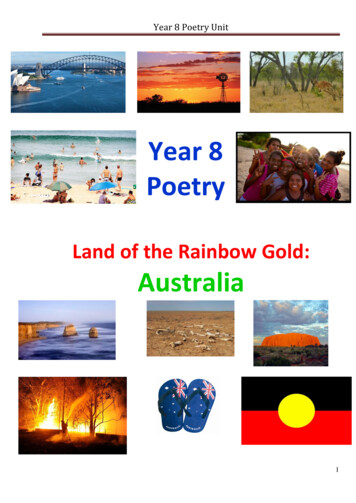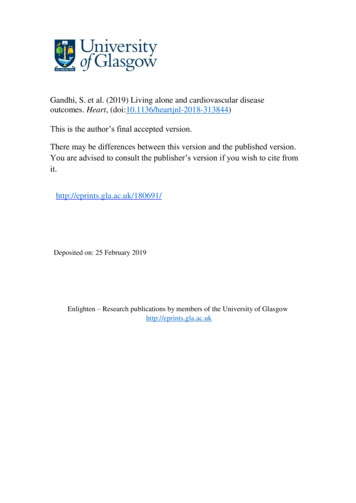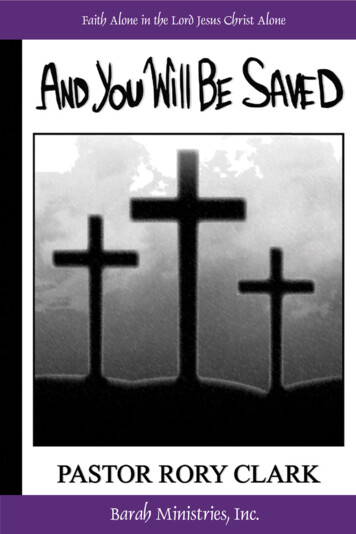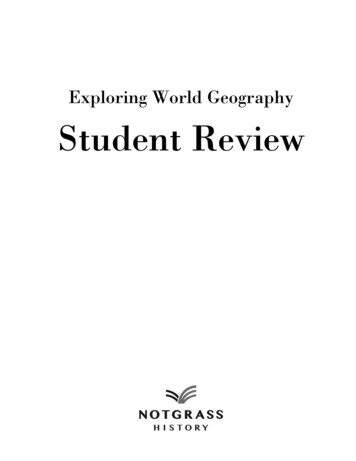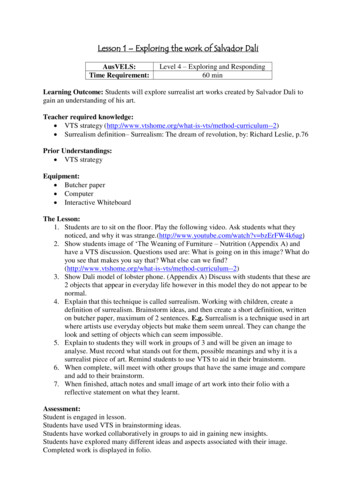
Transcription
CHI 2006 Proceedings Games and PerformancesApril 22-27, 2006 Montréal, Québec, Canada“Alone Together?” Exploring the Social Dynamics ofMassively Multiplayer Online GamesNicolas Ducheneaut1, Nicholas Yee2, Eric Nickell1, Robert J. Moore12Palo Alto Research CenterVirtual Human Interaction Lab3333 Coyote Hill Road, Palo Alto, CAStanford University, Stanford, .edu1But while HCI researchers [3, 5, 6, 16] and others [1, 4, 8,23, 24] have begun to investigate these popularentertainment communities, there is still surprisingly littledata available to understand how MMOGs function associal worlds. In particular, most of the current onlinegaming research tends to be based on self-reports obtainedfrom the players using interviews [23], surveys [16], orethnographic observations [3, 20]. Except for [6], no studiesare based on data obtained from the games themselves.ABSTRACTMassively Multiplayer Online Games (MMOGs) routinelyattract millions of players but little empirical data isavailable to assess their players’ social experiences. In thispaper, we use longitudinal data collected directly from thegame to examine play and grouping patterns in one of thelargest MMOGs: World of Warcraft. Our observationsshow that the prevalence and extent of social activities inMMOGs might have been previously over-estimated, andthat gaming communities face important challengesaffecting their cohesion and eventual longevity. We discussthe implications of our findings for the design of futuregames and other online social spaces.To address these limitations we study social activities inMMOGs based on longitudinal data collected directly fromgames. We use this data to compute “social accounting” [2]metrics allowing us to assess, for instance, how oftenplayers group with each other and how this affects theirprogress in the game. This provides us with a solidempirical foundation to better understand these complexsocial worlds. In this paper, we report on our study ofWorld of Warcraft, the most popular MMOG in the UnitedStates. We focus on three aspects of the game: play time,grouping (in the context of “quests” or missions), andguilds (longer-lived player associations). We describe theunique properties of massive gaming communities and whatthey can teach us about the design of successful onlinesocial spaces. In particular, we analyze the prevalence andextent of social activities to better understand if and how agame’s “social factor” can really contribute to its success.Author KeywordsOnline communities, Massively Multiplayer Online Games,social dynamics, activity metrics.ACM Classification KeywordsH5.m. Information interfaces and presentation (e.g., HCI):Miscellaneous.INTRODUCTIONMassively Multiplayer Online Games (MMOGs) havebecome a phenomenon of growing cultural, social, andeconomic importance, routinely attracting millions ofplayers [22]. The “social factor” is often advanced toexplain their popularity: in the words of one player, “it’s thepeople that are addictive, not the game” [12]. Indeed, mostof the activities offered by a MMOG (e.g. developing acharacter, fighting monsters) are already present in singleplayer games. What makes a difference for many isapparently the shared experience, the collaborative natureof most activities and, most importantly, the reward ofbeing socialized into a community of gamers and acquiringa reputation within it [8, 24].WORLD OF WARCRAFTA more “casual” multiplayer gameWorld of Warcraft (WoW) was launched to great acclaimby Blizzard Entertainment in November 2004. While it isbased on a classical formula inherited from MassivelyMultiplayer Online Role-Playing Games (MMORPGs) thathas been available for many years, WoW is clearly thegenre’s first breakthrough hit. The game sold out during itsfirst store appearance, attracting more than 240,000subscribers in less than 24 hours (more than any other PCgame in history). Its subscriber base expanded to 1.5millions in March 2005, later to reach 4 millions [22].Permission to make digital or hard copies of all or part of this work forpersonal or classroom use is granted without fee provided that copies arenot made or distributed for profit or commercial advantage and that copiesbear this notice and the full citation on the first page. To copy otherwise,or republish, to post on servers or to redistribute to lists, requires priorspecific permission and/or a fee.CHI 2006, April 22–27, 2006, Montréal, Québec, Canada.Copyright 2006 ACM 1-59593-178-3/06/0004. 5.00.It is interesting to note that earlier, Warcraft-themed gameshad been released by Blizzard – but none were MMORPGs.These games were immensely popular and it is quiteprobable that WoW’s initial growth was fueled in part by amigration of their fan base to this new game genre. As such,407
CHI 2006 Proceedings Games and PerformancesApril 22-27, 2006 Montréal, Québec, CanadaWoW helped broaden the appeal of MMORPGs byintroducing them to a new audience.allow players to perform game-related actions such ascasting spells or turning on special abilities. Playerscommunicate with each other by typing text in the “chatbox” at the lower left of the screen. Several communicationchannels are available: private, one-to-one “tells”; groupchat; guild chat; “spatial” chat (heard by all players within acertain radius); and finally “zone chat”, which reaches allthe players in a given zone of the game (zone chat is furthersubdivided into four channels: general, trade, local defense,and “looking for group”).As in previous MMORPGs, WoW players first create analter ego by choosing from eight different races (e.g.dwarves, orcs) and nine different character classes (e.g.mages, paladins). Once their character is created, playerscan begin questing in Azeroth, a medieval-fantasy worldbroadly inspired from the works of authors such as J.R.R.Tolkien. Azeroth is an extremely vast and richly detailed3D environment. Players can fight dangerous creatures(which may include other players) and explore the game’stwo continents alone or in the company of others whileundertaking quests. This allows them to earn “experiencepoints” and reach progressively higher “levels” (60 is thecurrent maximum), improving the abilities of their characterand acquiring powerful items along the way.Servers and world geographyIn order to break down the game’s large subscriber baseinto more manageable units, players must choose a specificserver to play on. Each server can host a community ofabout 20,000 players (there are 107 servers available in theU.S.). Three server types are available. The most commonis PvE (player versus environment) where players cannotkill other players by default, unlike PvP (player-versusplayer) servers. The third server type is RP (role-playing)for players who prefer to “stay in character” during thegame.On each server the world of Azeroth is divided into twocontinents, each further subdivided into zones. Players canfreely travel across these zones, either on foot or by usingvarious forms of public transportation (e.g. boats).However, each zone is home to creatures of a particularlevel range (e.g. Tanaris is a 40-55 zone) and could provedeadly to lower-level players. Each race has a capital city(e.g. Ironforge for the dwarves) that plays an important roleas transportation hub and place of commerce. Some of thesecapitals also host an auction house where players can tradeobjects on an open market. As such, they tend to be denselypopulated and frequently visited.Figure 1 - World of Warcraft’s interfaceUnlike previous MMORPGs however, WoW’s mostimportant claim to fame is its accessibility. MMORPGshave often been criticized for being “time sinks” requiringrepetitive, “grinding” tasks to gain experience points andprogress. As a consequence, they tend to be most popularamong “power gamers” who have an instrumental gameorientation [20]. Most game analysts, however, haveemphasized how WoW’s design rewards all players,whether they decide to play one hour or twenty hours aweek [9]. For instance, characters are considered to be in a“rest state” when they are not in the game. When playersreturn to a well-rested character they temporarily accrue50% more experience points – and this for as long as theyhave rested. As such, the more time players spend betweengaming sessions, the longer an experience bonus they get.This has been designed to allow the more casual players tocatch up with their more “hardcore” counterparts.Numerous other enhancements (see [9]) designed with asimilar philosophy have been implemented to help WoWattract a much larger subscriber base than its competitors.RESEARCH METHODSWe began our study of WoW by observing the game worldfrom the inside and started playing right after its launch inNovember 2004. All authors created a main character andseveral “alts” (secondary characters) on different servers.We picked different character classes to get as broad anoverview of the game as possible. We joined guilds, andparticipated in the community’s regular activities (quests –alone or in groups, guild raids, player-versus-playercombat, etc.). This provided us with a rich qualitativebackground to frame our analyses.We later moved to a complementary, more quantitativeresearch approach. WoW has been designed such that itsclient-side user interface is open to extension andmodification by the user community. In addition, the gameoffers by default a “/who” command listing the characterscurrently being played on a given server. These twofeatures have allowed us to develop a custom application totake a census of the entire game world every 5 to 15minutes, depending on server load. Each time a character isobserved our software stores an entry of the form:InterfacePlayers interact with the game and other players through aninterface that closely resembles those of previous onlinegames (see Figure 1). At the bottom several rows of buttons408
CHI 2006 Proceedings Games and PerformancesApril 22-27, 2006 Montréal, Québec, ,Ant Killers.significant reduction of time spent at level 39. Howevermounts are not free: players need to pay about 100 goldpieces (a significant sum of game money) both for trainingand for the mount itself. This explains the “crash” inleveling time right after reaching 40: players simply spendmore time gathering cash than earning experience pointsand progressing towards the next level. The “step” effect isa milder version of the above. Characters get access to newabilities at even levels – therefore, they work harder toreach them and spend less time at odd levels.The above represents a level 56 Night Elf Druid on theserver Alpha, currently in the Felwood zone, grouped ("y"),and part of the Ant Killers guild. Using this application wehave been collecting data continuously since June 2005 onfive different servers: PvE(High) and PvE(Low),respectively high- and low-load player-versus-environmentservers; PvP(High) and PvP(Low), their player-versusplayer equivalents; and finally RP, a role-playing server.Overall we observed 129,372 unique characters. We thenused the accumulated data to compute a variety of metricsreflecting the players’ activities.Overall, our data indicates that a player’s leveling time canbe obtained with the following equation:Leveling Time (in mins) (Current Level x 14.0) – 44THE SOCIAL DYNAMICS OF LARGE-SCALE GAMINGCOMMUNITIESIf we assume that current level 60s spent these amounts oftime while reaching level 60, then the average level 60character has an accumulated play time of 15.5 days - atotal of 47 8-hour work days, or roughly two full months ofwork days. A staggering 15% of all characters in WoW arecurrently level 60 and have played the equivalent of twoman-months in the short eight months since the game’srelease. The 10 day accumulated play time occurs aroundlevel 48 (25% of characters in WoW are at least this level).It is again important to note that we are counting charactersand not players. Actual play time would be higher forplayers who have multiple characters.Playing time and levelingSince MMORPGs are often described as extremely timeconsuming, and WoW actively tries to counter this trend,we started our analysis with an examination of playingtime. The average play time per character over a week was10.2 hours. Given that players are known to play multiplecharacters on their accounts, this average is probablysubstantially higher. In fact, it may not be much smallerthan the reported average of 21 hours of weekly play forthis game genre [26].Figure 2 - Average time required to reach a levelFigure 3 - Average accumulated play time by levelWe then analyzed how much time players spend movingfrom one level to the next (Figure 2). The progression isroughly linear with a mild dip at level 39 and a large spikeat 40. In other words, it takes people slightly less time to getto level 40 (playing harder) but then much longer to get to41. The curve also becomes steeper after level 53. Also ofinterest is the mild "step" effect throughout - leveling timeis shorter at odd levels and longer at even levels. Forexample, the average time to reach level 40 is 446 minutes,but the average time to reach level 41 is 622 minutes.The average play time rises only slowly, but very regularly(Figure 3). This indicates that WoW is a well-balancedgame where difficulty increases gradually with thepossibility of progress always within reach – a reward cyclethat made previous MMORPGs addictive [23]. In fact, thecurve above is reminiscent of Skinner’s concept of operantconditioning [17]. WoW begins with almost instantgratification but, as soon as the player masters the initialtasks and they become trivial, they are replaced by slightlymore difficult tasks – along with the promise of betterrewards (e.g. more skills, travel to new zones, etc.). Beforelong one-click rewards disappear and players findthemselves spending dozens of hours trying to obtain a newsword, or spending “just a few more minutes” to reach thenext level. Game designers know the power of such areward structure [11] but putting it into practice is notThis data illustrates how instrumental game objectivesstrongly affect a MMORPG player’s behavior. Reachingthe 40th level in WoW opens the possibility of riding amount – a way to travel across the world 60% faster, and asignificant social status marker of being a “high level”character. This apparently encourages players to “workharder” to reach this coveted objective, resulting in a409
CHI 2006 Proceedings Games and PerformancesApril 22-27, 2006 Montréal, Québec, Canadanecessarily trivial. The fact that WoW offered such asmooth progression curve “out of the box” (the game hasnot been changed substantially since its launch) points atthe time and care that went into designing its internalmechanics.plotted the average time it took them to complete a levelacross all the levels. As Figure 6 shows, characters who arenever in a group consistently level faster than characterswho group at any frequency. In fact, the former are abouttwice as efficient in leveling as the latter.The “social factor:” grouping patternsWoW encourages players to form groups using two classicmechanisms. First, character classes have specific abilitiesthat complement each other (e.g. Priests are the besthealers, Warriors the best melee fighters, etc.). As such,grouping with players of a different class should increaseefficiency. Second, many quests and dungeons in the gameare simply too difficult to be tackled alone. Players have toform either a party (5 players maximum) or even a raid (40players maximum) to have a chance to win the powerfulitems available in these difficult locations.Figure 5 - Fraction of time spent in groups, by levelThis data paints a more nuanced picture of the social natureof MMORPGs than was previously available. Grouping isapparently an inefficient way to level and many players arenot observed to be in a group until they are past level 55.Players prefer “soloable” classes and it is only in the verylate stages of the game, where dungeons are simply toodifficult to enter alone, that the grouping rate rises.Therefore WoW seems like a game where the endgame issocial, not the game as a whole. One player summarizedthis situation nicely by saying that WoW’s subscribers tendto be “alone together:” they play surrounded by othersinstead of playing with them. We discuss this importantphenomenon in more detail later in this paper.Figure 4 - Average time spent in a group, by classDespite the complementarity of classes however, somestand a better chance of survival alone than others. Forinstance, Hunters are accompanied by a powerful pet,effectively allowing a single player to control a twocharacter unit. In the words of the players we talked to, thismakes Hunters a more “soloable” class. We computed theaverage time spent in a group for each class and thenumbers clearly reflect their “soloability” (or lack thereof)– see Figure 4. The differences are significant, F(8,129372) 152.99, p .001, with the most soloable class (Warlocks)spending about 30% of their time grouped versus the 40%spent by Priests at the other end of the distribution.Interestingly, the more “soloable” classes tend to be themost popular. When we computed the class distributionover the entire population, the three most-played classes(Warrior, Hunter, and Rogue) were among those spendingthe least time in groups (less than 32%).We wondered however if grouping behavior changed ascharacters gained in level. It appears time spent in groupsincreases about linearly with levels to stabilize at around40%. There is then a strong increase in grouping startingafter level 55 and, starting at level 59, more than half ofplay time is spent in a group (Figure 5).Figure 6 - Impact of grouping on leveling timePersistent relationships: guilds and their impactAbove we observed grouping practices in the context ofquests – short-term missions players have to accomplish toearn experience points. However, there are also longerlived player associations in WoW: the guilds. Guilds areoften cited as another important factor contributing toMMORPG’s popularity. They are the place where most of aAnother interesting aspect to consider is the impact ofgrouping on progress in the game. We split characters intofour bands of grouping ratio (e.g. characters in the 0-1%band were almost never observed to be in a group) and then410
CHI 2006 Proceedings Games and PerformancesApril 22-27, 2006 Montréal, Québec, Canadaplayer’s important relationships are formed and frame aplayer’s social experience in the game [8, 16, 23]. Our datashows that, overall, 66% of WoW’s characters are in aguild. Moreover, this number increases to 90% forcharacters level 43 and above. This last number is quiteclose to data obtained from earlier games [23].Size of guilds and commitment levelsAll guilds are not created equal: there are significantvariations in their size. 17.5% of characters were observedto be in a guild that no one else was observed to be induring the sample period - i.e., a “one-person guild”. Theaverage guild size was 14.5 (16.8 if one-person guilds areexcluded) – much smaller than reported in previous surveydata [16]. The median was 6 (9 if one-person guilds areexcluded), and the largest observed guild had 257 members.The 90th percentile of the distribution is 35, a fairly lowthreshold that apparently few guilds manage to pass.Impacts of guild membership on playing time and groupsSince guild membership is so prevalent, we measured theeffects it has on playing time. It has been proposed thatguilds put “social pressure” on their members to play longer[16]. Indeed, guilds often organize raids and other eventsrequiring planning, which could create a sense of obligationfor the members. An ANCOVA with guild status as theindependent variable, weekly playing time as the dependentvariable, and average level as the covariate revealed thatplayers in guilds spend more time in the game than others,F(1,120505) 552.87, p .001. Our data therefore seemsto confirm the “social pressure” hypothesis.We also tried to evaluate the players’ level of commitmentto their guild. Of 2,744 guilds observed during a one-weekperiod in June, 21% were not observed again during a oneweek period in July. However, many of these guilds (19%)were only observed with one character in June. If we onlytake into account guilds with more than one member the“death rate” is 13%. Of the guilds that were observed inboth June and July (N 2168), the average change in guildsize was exactly 0. In other words, on average, guilds didnot grow or shrink over this one-month period. This wassomewhat surprising given that we might have expectedguilds to grow over time. In fact, if we exclude all “oneperson guilds”, the average change is mildly negative (.13). On the other hand, the range of change in guild sizewas quite large (largest loss: 103; largest gain: 87).Plotting playing time against level by guild involvementshows another interesting trend: playing time is more stableafter level 40 for guilded players and fluctuates more fornon-guilded ones (Figure 7). As we mentioned earlier,being close to new skills (at odd levels) increases playingtime while being far away from new skills (at even levels)decreases playing time. It seems that this effect could bestronger for non-guilded players who have more controlover their playing time and weaker for guilded players whoare also playing for social obligations, especially in thelatter stages of the game where dungeons and instancesoften require several hours of group play to be completed.Overall this tends to indicate fairly low levels ofcommitment to guilds, perhaps lower than previouslyreported [16]. The “death rate” is high with almost a quarterof the guilds disappearing each month. Within the survivingguilds the “churn rate” is also high, with a large fraction ofthe members leaving to be replaced by new ones. Ithighlights the difficulty of managing and sustaining theseentertainment-based communities.Social networks in guildsFinally, we tried to evaluate the kind of social environmentprovided by a guild. We built social networks for each guildin our sample using two different methods: one to assess theguild’s potential for sociability and the other to quantifyjoint activities.With the first approach, players are connected to each otherif they are observed online at the same time, irrespective oftheir game location (the strength of the tie is proportional tothe time two characters overlap). The resulting networkreflects the range of opportunities for social interaction in aguild. Indeed, it connects players who have the opportunityto chat using the “guild” channel and who are listed in the“guild members” window each time a player logs on. Inother words, it lists the range of guildmates known (but notnecessarily talked to or played with) by each player. Insocial networking terms, these connections could be calledweak [7] or “bridging” [14] ties.Figure 7 - Guild membership and playing time, by levelCharacters belonging to guilds also group more often andthis effect becomes more pronounced over the levels. In anANCOVA with guilded (yes/no) as the independentvariable, average grouping ratio as the dependent variable,and level and playing time as the covariates, the effect ofbeing in a guild was significant, F (1,120505) 927.84,p .001. For example, between levels 41-60, characters in aguild are in a group about 43% more often than charactersnot in a guild, after playing time has been controlled for. Ittherefore seems that being in a guild facilitates finding andforming an ad-hoc quest group.Our second type of social network connects players who areobserved to be in the same zones of the game, excluding the411
CHI 2006 Proceedings Games and PerformancesApril 22-27, 2006 Montréal, Québec, Canadamajor cities. Such a network highlights players who arespending time together, grouping with guildmates to runquests and visit dungeons. These are stronger, “bonding”[14] ties based on mutual interest in the same gameactivities.remain beneficial. Note that, for guilds with 16 to 60members, the average main core is between 6 and 9.Considering that the maximum quest party size in WoW is5, this probably means that the core players in these guildshave formed at least one, sometimes two stable questgroups. Guilds with 61 to 120 members probably have 3such groups. And finally, guilds with more than 120members have a large enough core (about 22) to form acredible raid group in order to tackle the toughest dungeons.We computed each guild’s social network degree density(Table 1) [21]. We limited this analysis to guilds having 6members or more (densities in small networks can often beunreliable [21]). The numbers were surprisingly low: onaverage, it seems that players know at most 1 out 4members of their guilds, and play only with 1 out of 10(Table 1, row 1). Guilds are sparsely knit networks – asurprising finding, considering the effects they have on playpatterns. Moreover, density is inversely correlated with size(-.15): as guilds grow, it becomes more difficult to knowand play with most of the members.Guild sizeAll 6NMeanMedian6 – 15NMeanMedian16 – 30 NMeanMedian31 – 60 NMeanMedian61 – 120 NMeanMedian 890.270.256180.220.203670.180.172440.170.14We also observed that players belonging to the core of aguild do not simply play with many guildmates, they playwith them longer. We computed that, on average, any twomembers in a guild spend 22.8 minutes playing togetherover a 30-day period, while for core members the average is154 minutes. Guild cores are “tight” sub-groups. Finally,our data shows that a large majority (65%) of guilds have asingle core group. A few guilds (13%) have two cores, andfewer still (4%) have 076180.050.043670.030.022440.040.01Figure 8 – Co-location network in a medium-sized guildTable 1 – Social network densitiesFigure 8 illustrates the co-location network for a typical,medium-sized guild. Out of the 41 members, 17 were neverobserved in the same zone as another guildmate. Among the24 remaining there is a main core of 8 players activelyplaying together, with a really active central trio (their thickties show they spend a lot of time together). The other 13players are only peripherally connected and play with 2 orfewer guildmates.Since guilds tend to be sparsely knit, we then tried toidentify cohesive subgroups within them. We performed ak-core decomposition [21] for each guild in our five sizecategories, using the co-location networks. Each k-core is asubgraph where each player is adjacent to at least k others.The main core (the k-core with the largest k) gives the sizeof the most cohesive subgroup (Table 2).Differences between serversThe metrics we reported above are based on observationsacross all servers. We explored whether or not the type ofserver had a significant impact on our results. In particular,our hypothesis was that PvP servers could have largerguilds with players more inclined to grouping – both wouldsimply increase a player’s chance of survival (a commonoccurrence on PvP server is to be “ganked,” that is, to bekilled by other players while traveling alone). However thedifferences were surprisingly small overall. Characters onPvP servers played about an hour more (70 minutes) perweek, and grouping rates differed in the direction wehypothesized (30% of time spent in groups instead of 25%,across all 60 levels). No other differences were apparent.Table 2 - Main core size for the five guild categoriesThe ratio of main core size to guild size is inverselycorrelated with size (-.17), decreasing from 37% to 12%. Inother words, growing a guild has diminishing returns as faras forming tight play groups is concerned: a smaller andsmaller fraction of the additional recruits will join the core.Still, our data illustrates why having a large guild can412
CHI 2006 Proceedings Games and PerformancesApril 22-27, 2006 Montréal, Québec, CanadaSince the differences are quite small, we are confident thetype of server does not seriously affect the playing patternswe observed. With this in mind, we will now discuss theimplications of our findings.The other players: friends or audience?When asked about the reasons behind their attraction toMMORPGs, most players answer by mentioning “the socialfactor:” it is the presence of other people in these games’worlds that sets them apart [12, 16, 26]. Studies of earlierMMORPGs refined this picture by emphasizing theimportance of joint activities and time spent in groups [8].However, our study of WoW shows that grouping may notbe what most players are after. Indeed, a large number ofplayers stay outside of groups for most of their tenure in thegame. Of course, we know that not all players enjoysocializing [1]. Still, considering how large WoW’spopulation is, the lack of grouping cannot be entirelyattributed to playing styles.DISCUSSIONDesigning a successful massively multiplayer gameOur analyses shed light on many of the unique properties ofWoW, some confirming earlier studies of competingMMORPGs and others more surprising. Above all it seemsclear that, despite claims to the contrary, WoW’s successcannot be entirely explained by its “casual” nature. Whileplayers tend to log into the game less than in its earliercompetitors, WoW still consumes a very significant amountof leisure time from its subscribers.These numbers, complemented by our ethnographicobservations of the game, have led us to a differentdefinition of the role of other players in MMORPGs. Whilemany of WoW’s subscribers play alone, we believe theyprefer playing a MMORPG to playing a comparable singleplayer game because of a different kind of “social factor.”Indeed, the other players have important roles beyondproviding di
Massively Multiplayer Online Games Nicolas Ducheneaut1, Nicholas Yee2, Eric Nickell1, Robert J. Moore1 1Palo Alto Research Center 3333 Coyote Hill Road, Palo Alto, CA {nicolas,nickell,bobmoore}@parc.com 2Virtual Human Interaction Lab Stanford University, Stanford, CA nyee@stanford.edu ABSTRACT Massively Multiplayer Online Games (MMOGs) routinely





